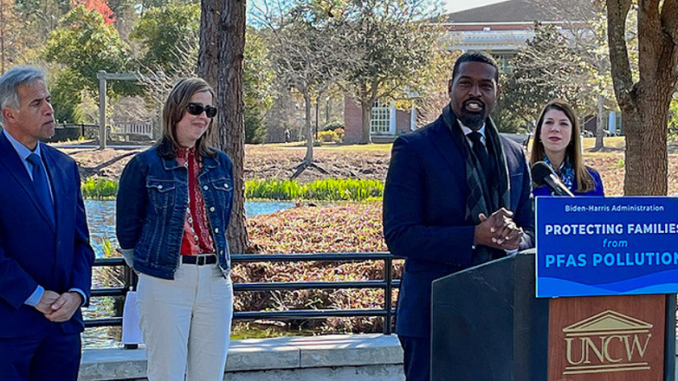
WASHINGTON, DC, March 14, 2023 (ENS) – The Biden Administration today proposed the first national drinking water standard for six harmful “forever chemicals” in the latest action under President Joe Biden’s plan to combat PFAS pollution and EPA Administrator Michael Regan’s PFAS Strategic Roadmap.
Through this action, the U.S. Environmental Protection Agency, EPA, is taking action to protect public health from per- and polyfluoroalkyl substances, PFAS, called forever chemicals because they don’t break down but persist in the environment.
EPA predicts that if fully implemented, the rule would, over time, prevent thousands of deaths and reduce tens of thousands of serious illnesses linked with PFAS exposure.
PFAS are a category of manufactured chemicals that can cause serious health problems, including cancer, if people are exposed to them over a long period of time. The first PFAS chemicals were created in the 1930s and used as ingredients in nonstick coatings. Today, more than 9,000 PFAS have been identified.
Research involving humans suggests that high levels of certain PFAS may lead to: increased cholesterol levels, decreased vaccine response in children, changes in liver enzymes, increased risk of high blood pressure or pre-eclampsia in pregnant women; small decreases in infant birth weights, and increased risk of kidney or testicular cancer.
The EPA is leveraging the latest science and complementing state efforts to limit PFAS by proposing to establish legally enforceable levels for six PFAS known to occur in drinking water. This action establishes nationwide protection from PFAS pollution for all people, including environmental justice communities.
“EPA’s proposal to establish a national standard for PFAS in drinking water is informed by the best available science, and would help provide states with the guidance they need to make decisions that best protect their communities,” Regan said.
“This action has the potential to prevent tens of thousands of PFAS-related illnesses and marks a major step toward safeguarding all our communities from these dangerous contaminants,” he said.
This proposal builds on other key milestones to combat PFAS, including:
- – EPA’s proposal to designate two PFAS as hazardous substances under the law governing Superfund sites, the Comprehensive Environmental Response, Compensation, and Liability Act, CERCLA
- – enhancing data on PFAS under EPA’s National PFAS Testing Strategy and through nationwide sampling for 29 PFAS in public drinking water systems;
- – using EPA’s Clean Water Act permitting and regulatory programs to reduce PFAS pollution in the environment from industry; and
- – initiating the distribution of $10 billion in funding to address emerging contaminants under the Bipartisan Infrastructure Law.
The proposal, if finalized, would regulate PFOA and PFOS as individual contaminants, and would regulate limit any mixture containing one or more of the chemicals PFNA, PFHxS, PFBS, and/or GenX Chemicals.

PFOA and PFOS: EPA is proposing to regulate PFOA and PFOS at a level they can be reliably measured at four parts per trillion.
“Communities across this country have suffered far too long from the ever-present threat of PFAS pollution. That’s why President Biden launched a whole-of-government approach to aggressively confront these harmful chemicals, and EPA is leading the way forward,” EPA Administrator Michael Regan said.
If finalized, the proposed regulation would require public water systems to monitor for these chemicals. It would also require systems to notify the public and reduce PFAS contamination if levels exceed the proposed standards.
“I applaud Administrator Regan and President Biden for taking this bold step forward that will help ensure our water is safe for New Hampshire families and that parents have the peace of mind they deserve when they turn on the tap,” U.S. Senator representing New Hampshire Jeanne Shaheen, a Democrat, said.
PFNA, PFHxS, PFBS, and GenX Chemicals: For these PFAS, water systems would use an established approach called a hazard index calculation, defined in the proposed rule, to determine if the combined levels of these PFAS pose a potential risk.
“This has long been a top concern for me and is why as a lead negotiator of the water provisions in the bipartisan infrastructure bill, I fought to include a historic level of funding – $10 billion – to combat PFAS exposure. These dollars will be crucial in providing our municipalities with the resources they will need to comply with these new regulations so that together we can prioritize clean water for our communities,” Senator Shaheen said.
She urged the Biden Administration to swiftly ensure “timely allocation of funds from the infrastructure bill to assist public water operators as they begin work to meet these new enforceable drinking water levels.”
“I have long supported the implementation of a national drinking water standard to ensure that the water in our communities is clean and safe for consumption,” said Republican Congressman Brian Fitzpatrick who represents Pennsylvania and co-chairs the Bipartisan Congressional PFAS Taskforce. “Today’s announcement is a step in the right direction as we work to prevent the future contamination of PFAS ‘forever chemicals’ in our water, and I look forward to continuing to work with the administration to enforce a high standard of water quality.”

“After decades of delay, President Biden’s EPA has delivered a drinking water standard for PFOA and PFOS which, when finalized, will be the toughest in the nation,” said activist and actor Mark Ruffalo. “By proposing to regulate four other PFAS as a mixture, the Biden EPA is also putting our communities ahead of the polluters. President Biden and his team pledged to make PFAS a priority and he has delivered. No administration has done more to address the urgent threat posed by these toxic forever chemicals than the Biden Administration.
“My message to polluters is simple: after poisoning your workers and neighbors for decades, it is time to make our public health, not your profits, our top priority. My message to communities devastated by PFAS pollution is equally simple: help is finally on the way,” Ruffalo said.
“Everyone deserves access to health-protective drinking water. It is a basic human right. We applaud the Biden EPA for having the courage to do what multiple administrations could not. Today is a good step towards tackling our nation’s massive PFAS public health crisis by including commercially relevant PFAS like GenX. We now need every office within the EPA and all other federal agencies to use a whole of government approach to address PFAS as a class, stop all exposures at their source, make responsible parties pay for the clean-up, and give overexposed communities access to health monitoring,” Emily Donovan, co-founder, Clean Cape Fear, said.
Erik Olson, senior strategic director for health with the Natural Resources Defense Council said, “EPA’s groundbreaking proposal to regulate six PFAS ‘forever chemicals’ for the first time is crucially important. We have a five-alarm fire. Setting strong standards will help ensure the fundamental right of every family to have safe water flowing from their kitchen tap.”
“We must crack down on PFAS polluters,” Olson said. “They should be required to halt further pollution, clean up the contamination they’ve already caused, and pay to treat PFAS-contaminated drinking water. Most of us learned in kindergarten that we should clean up our own messes,but it seems like big chemical corporations never learned that lesson.”
President Biden has secured historic funding to address emerging contaminants like PFAS, including $10 billion from the Bipartisan Infrastructure Law.
EPA will continue to work with federal, state, territorial, and Tribal governments and drinking water systems to address PFAS in drinking water and implement solutions to reduce human health risks. In addition, EPA is committed to taking broader actions to help reduce Americans’ exposure to PFAS, including:
- – Monitoring thousands of drinking water systems across the country for dozens of PFAS, beginning this year;
- – Taking final action on a proposal to designate two PFAS as “hazardous substances” to help hold polluters accountable;
- – Restricting PFAS discharges to our waterways by strengthening Clean Water Act standards;
- – Finalizing chemical data and safety rules that will increase our knowledge about PFAS, allow us to act faster and more strategically, and restrict legacy PFAS from reentering production; and
- – Considering public comments submitted on today’s proposed rule toward taking final action on nationwide PFAS drinking water standards.
For more information on this proposal, please visit EPA’s Per- and Polyfluoroalkyl Substances (PFAS) webpage at: https://www.epa.gov/pfas
EPA requests input on the proposal from all stakeholders, including the public, water system managers, and public health professionals. Comments may be submitted through the public docket, identified by Docket ID No. EPA-HQ-OW-2022-0114, at www.regulations.gov.
Featured image: EPA Administrator Michael Regan announced a proposal to limit PFAS in the nation’s drinking water. March 14, 2023, Wilmington, North Carolina. (Photo courtesy City of Wilmington via Twitter)



